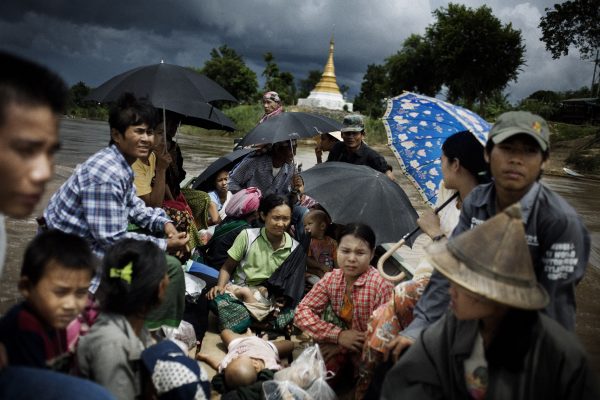This ethnic diversity ranges the length and breadth of the country but is concentrated in the highlands. It is from these remote regions, nestled against the borders with Bangladesh, India, China, Laos and Thailand, that other influences are drawn into the Myanmar fray. Every central government has struggled with this intermingling of diversity, and the power of cross-border connections.
In response, government policy has sought to enforce a single centralised union, where minority claims to self-determination and autonomy have been vigorously stamped out.
That the best organised of the ethnic groups have resisted these efforts has led to rolling civil war, going right back to the 1940s. The major ethnic armed groups — such as the United Wa State Army, Kachin Independence Army and Karen National Liberation Army — are the product of these decades of antigovernment insurrection.
For the past quarter century the government has sought to arrange ceasefires with its armed opponents. These have proved only moderately successful.
Indeed there are still no final peace agreements and the precarious status of the ceasefire deals ensures they are subject to regular renegotiation. In 2014 the government made an extra push to finalise a nation-wide peace agreement in the lead-up to the 2015 general election. It is unclear when the final deal will be done.
For now, this leaves the government with an array of unwieldy issues to manage. There is the need, from the official perspective, to ensure that national unity is maintained. In the context of Myanmar’s guiding narrative of harmony and inclusion the rumblings of ethnic armies and their secessionist struggles have been inconvenient. Understanding the aspirations of ethnic peoples has required patience and savvy.
Offering economic incentives and concessions has proved one effective strategy. Ceasefires in Myanmar have tended to be accompanied by commercial tie-ups that have funnelled new wealth into the pockets of ethnic leaders. With abundant mineral reserves, to say nothing of the money to be made from trade, logging and construction, there has been much wealth to go around.
A number of Myanmar’s most successful companies, including the gigantic Asia World conglomerate and the politically potent Jadeland, have emerged directly from the ceasefires. Ethnic commercial leaders, their coffers bursting with loot, have often worked with the government to weld peaceful interactions together.
Such arrangements have been subject to turbulence, with some of the key ceasefires breaking down in recent years. In 2011, for example, the Kachin Independence Army went back to war with the central government after a 17-year truce. The new war was bloody, with reports of thousands of casualties in the two years of heavy fighting. More than 100,000 people were displaced from their homes. Even though most of the fighting is over, many are still languishing in hastily constructed camps in Kachin State and northern Shan State. Some of these refugees were forced to huddle together along the border with China as the war raged around them.
This pitiable situation has been the experience for generations of people from minority backgrounds, with millions forced to find sanctuary in Thailand, Bangladesh, Malaysia and further afield. Myanmar government counter-insurgency campaigns have often worked to eliminate the support that villagers and townsfolk offer ethnic rebellions. The results are found in long lists of egregious human rights violations. The trauma of these wars is no small thing.
With this history, precisely how the Myanmar government should best include minorities in the ongoing national reform process is the subject of much debate. It all hinges on the result of the next election, scheduled for later in 2015.
Looking at the electoral maths, minority voters are likely to disperse their affections across dozens of parties. The election result, and the shape of the next government, will thus be determined by the performance of the opposition National League for Democracy and the incumbent Union Solidarity and Development Party.
Both of these major parties also draw support from ethnic voters and will offer candidates from ethnic minority backgrounds in 2015. In many areas they will go toe-to-toe with popular alternatives from different ethnic minority political parties. Powerful Mon, Karen, Shan, Chin, Kachin and Rakhine parties are expected to do well in their areas of the country. Most analysts expect the ethnic vote will fracture wildly, meaning that some unexpected victories will occur in a first-past-the-post system where second preferences count for nought.
While it doesn’t get the attention it deserves, it is this emerging pattern of complex ethnic politics, partly driven by the government’s co-optation of ethnic leaders, that will likely determine just how successful the overall reform process becomes. The bottom line is that if Myanmar’s minorities can’t find sufficient space for their cultural, political and economic interests then the alternative, history suggests, is further war.
To avoid that prospect Myanmar’s majority Bamar population will need to more fully accommodate the aspirations of those minorities who find the union an uncomfortable place to be. Rhetoric of national belonging and inclusion rings hollow after so many decades of torrid conflict. The goal for the Myanmar government must be to find a sustainable approach to managing these problems.
That means sharing much more power and listening much more carefully. For long-term happiness, Myanmar’s minorities will be seeking greater autonomy and the chance to defend their cultural heritage. Even if all goes well, balancing their interests against those of the majority will be a permanent conundrum.
Dr Nicholas Farrelly holds an Australian Research Council fellowship for a study of Myanmar’s political cultures ‘in transition’. He is also the co-founder of New Mandala and the Director of the ANU-IU Pan Asia Institute.
This article appeared in the most recent edition of the East Asia Forum Quarterly, ‘Asia’s Minorities‘.

